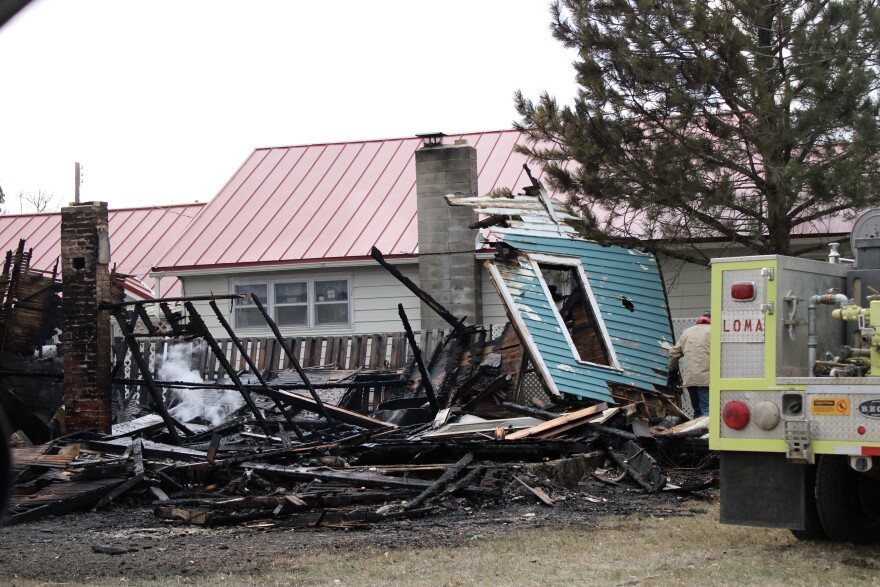High winds, months of drought and record temperatures fueled wildfires in central Montana this week that burned thousands of acres. Dozens of homes, grain elevators and bridges have been lost.
“I just want to show you a picture," said resident Jamie Reid. "That’s our house.”
It’s hard to tell a house once stood in the spot that Reid holds a picture of. It’s now a pile of charred, smokey rubble.
“It’s in the ground because we had a basement,” Reid's 13-year-old son Dreygon said.
The house collapsed in on itself.
Reid, her husband and their two sons moved into their two-bedroom, one-bath house in Denton just a year ago to be closer to relatives. They’re one of about 20 families in town who lost a house to the West Wind fire that sparked Tuesday.

It was one of three late-season wildfires this week that forced evacuations of residences near Browning, Great Falls and in Denton. No significant injuries or deaths have been reported.
After evacuating, the Reids went to the Fergus County Fairgrounds, where the local extension office is collecting donated clothes, toiletries and food for displaced residents. The Reids were able to grab a handful of clothes and some family photos. Everything else was destroyed.
"We had all of the boys’ Christmas presents in there,” Reid said.
The West Wind fire started in grasslands before whipping through town, engulfing some structures while leaving others still standing right next door.
Pat Hocevar helps run the only grocery store in Denton, which was spared from the blaze. A building across the alley was lost. Hocevar was in his shop when he first saw the fire hit town. He said it was hard to tell which direction flames were coming from and where they were going.
"You couldn’t see the fire because all you could see was smoke," he said. "Had places where you’re 100 feet, the fire burns right by you and you don’t even see it because there’s so much smoke in the air."

Around 150 firefighters from several agencies descended on the town as the more than 200 residents evacuated.
Don Pyrah, a fire management officer with the Department of Natural Resources and Conservation in the area, said 70 mph winds and historic drought made it impossible for crews to use normal tactics to fight the fire.
“In spite of having all of the stuff in the world we can get, there’s just some things that we're still limited," he said.
"Mother nature still has the trump card.”
Pyrah called the wildfire a traumatic event for all involved.
Another grass fire fed by high winds burned through the Gibson Flats neighborhood in Great Falls early Wednesday morning.
The local sheriff’s office says 11 homes, seven garages and 11 outbuildings were destroyed.
Cherie Stone was thankful to find her home still standing in Gibson Flats when she returned. She had left two days prior at about 3 a.m. when a neighbor called to tell her his house was on fire.
“I went upstairs and I saw the fire and I just, I grabbed my pets, my phone and my computer and I left right away," Stone said.
She lost a corral and her grandson's Chevy Nova. She’s also feeling a mental toll.
“Yeah, I’m getting a little bit emotional about it," Stone said. "I woke up this morning, felt like I was beaten because my body was so sore, I think it's just from all the nerves.”
Montana saw the first of its major wildfires of 2021 in June. It’s rare for major fires to occur in December. But the potential for significant wildland fires continues.

An outlook published by the National Interagency Fire Center says more than 90% of the U.S. West is in drought, and a large swath of Montana faces above average fire potential for the rest of the month.
University of Montana fire ecologist Phil Higuera says wildfires are now starting more easily and spreading more rapidly after ignition, fueled by a combination of things.
"Much of the area in central Montana is, and has been, in exceptional drought for multiple months now," he said.
Higuera says drought, combined with powerful wind and human-caused ignitions, are a recipe for wildfire disaster.
He says it’s a pattern scientists are seeing more frequently as the climate warms and dries.
“When we zoom out and look across the west," he said, "one of the key statistics about our increasing fire activity is the lengthening of the fire season."
MTPR's Edward O'Brien contributed to this story.
Copyright 2021 Montana Public Radio. To see more, visit Montana Public Radio.


